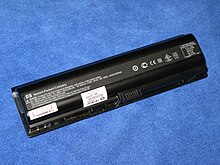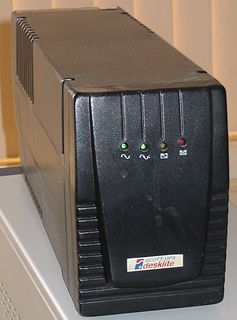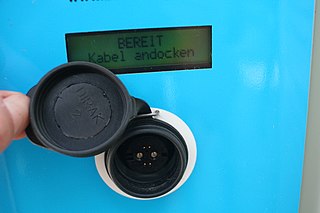This article includes a list of references, related reading or external links, but its sources remain unclear because it lacks inline citations .(January 2015) (Learn how and when to remove this template message) |


A smart battery or a smart battery pack is a rechargeable battery pack with a built-in battery management system (BMS), usually designed for use in a portable computer such as a laptop. In addition to the usual positive and negative terminals, a smart battery has two or more terminals to connect to the BMS; typically the negative terminal is also used as BMS "ground". BMS interface examples are: SMBus, PMBus, EIA-232, EIA-485, [1] and Local Interconnect Network.

A battery pack is a set of any number of (preferably) identical batteries or individual battery cells. They may be configured in a series, parallel or a mixture of both to deliver the desired voltage, capacity, or power density. The term battery pack is often used in reference to radio-controlled hobby toys and battery electric vehicles.
A battery management system (BMS) is any electronic system that manages a rechargeable battery, such as by protecting the battery from operating outside its safe operating area, monitoring its state, calculating secondary data, reporting that data, controlling its environment, authenticating it and / or balancing it.

A portable computer was a computer designed to be easily moved from one place to another and included a display and keyboard. The first commercially sold portable was the 50 pound IBM 5100, introduced 1975. The next major portables were Osborne's 24 pound CP/M-based Osborne 1 (1981) and Compaq's 28 pound 100% IBM PC compatible Compaq Portable (1983). These "luggable" lacked the next technological advance, not requiring an external power source; that feature was introduced by the laptop. Laptops were followed by lighter models, so that in the 2000s mobile devices and by 2007 smartphones made the term almost meaningless. The 2010s introduced wearable computers such as smartwatches.
Contents
Internally, a smart battery can measure voltage and current, and deduce charge level and SoH (State of Health) parameters, indicating the state of the cells. Externally, a smart battery can communicate with a smart battery charger and a "smart energy user" via the bus interface. A smart battery can demand that the charging stop, request charging, or demand that the smart energy user stop using power from this battery. There are standard specifications for smart batteries: Smart Battery System [2] , MIPI BIF and many ad-hoc specifications.

A smart battery charger is mainly a switch mode power supply that has the ability to communicate with a smart battery pack's battery management system (BMS) in order to control and monitor the charging process. This communication may be by a standard bus such as CAN bus in automobiles or System Management Bus (SMBus) in computers. The charge process is controlled by the BMS and not by the charger, thus increasing security in the system. Not all chargers have this type of communication which is commonly used for lithium batteries.
Smart Battery System (SBS) is a specification for managing a smart battery, usually for a portable computer. It allows operating systems to perform power management operations via a smart battery charger based on remaining estimated run times by determining accurate state of charge readings. Through this communication, the system also controls the battery charge rate. Communication is carried over an SMBus two-wire communication bus. The specification originated with the Duracell and Intel companies in 1994, but was later adopted by several battery and semiconductor makers.








